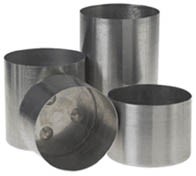Mold Techniques for Candle Making

It seems in today’s market one segment which can go overlooked is the Free standing or “pillar market”. Nothing can complement the line like a nice pillar candle.
Pillars are a logical progression because these types of candles are easy to make, smell great, and are relatively easy to maintain.
One way to bring in new customers and increase sales is to offer new and unique candles that are not offered by your competition. This can easily be achieved by learning how to make freestanding or pillar candles using a variety of mold techniques.
According to the National Candle Association, candle users say they most frequently burn candles in the living room (42%), followed by the kitchen (18%) and the bedroom (13%).
One may assume that aesthetics are important in the living room and creating beautifully unique pillars that burn cleanly could be a great way to increase your sales. The following tips and tricks should help you with increasing your free standing candle offering.
- Aluminum molds are heat resistant, durable, and leave no ugly seams in the finished candle. The finished candles are professional looking and have an extremely smooth finish.
- Pillar Pins are a great way to increase production while maintaining perfectly straight wicks. Once mastered they are a necessity for making pillars efficiently.
- If you are using rubber plugs to seal the wick hole, place molds on two parallel strips of wood or other material that allows you to keep molds level.
- Adjust pouring temperature to achieve different effects. If candles are not de-molding easily, try raising pour temperature a bit.
- Leave an extra few feet of wick coming from the bottom of the mold. This way fresh wick comes up through the wick hole when you remove the finished candle, thus eliminating the need to push wick through the tiny hole for the next candle.
- You can carefully trim the mold down the sides or where needed with a sharp razor blade.
- Rub a very small amount of petroleum on the seam to help smooth seams. While you are rubbing the petrolatum on the seam, use the opportunity to verify you have the mold correctly lined up.
- Use picture wire or a D-string from a mandolin to help you wick the mold the same way you would thread a needle.

- Be sure to use the correct wax designed for free standing candles. If you use the wrong wax or incorrect temperature, it can be tricky getting the mold cleaned out.
- Do not pour wax into the mold if it is over 200 degrees or damage to the mold may occur.
In addition to the above types of molds, we recently wrote about how easy custom size molds can be created. Making custom molds can increase your presence even more because those types of shapes/sizes will probably not be made by the larger candle producers. A key point to stress is that you must continually update and reinvent your line.




What waxes work best in these molds? I gave almost given them up!
The best wax to use when making molded candles and adding fragrance is the CBL-141.
https://candlewic.com/p/candle-making/wax/candlewic-custom-blends/votive-pillar-blend-wax-cbl-141/
Great idea! I sell a lot of palm wax pillars and am working on beeswax pillars now.
What type of wax does cbl-141 contain?
CBL-141 is a blend of paraffin wax, vybar and stearic.